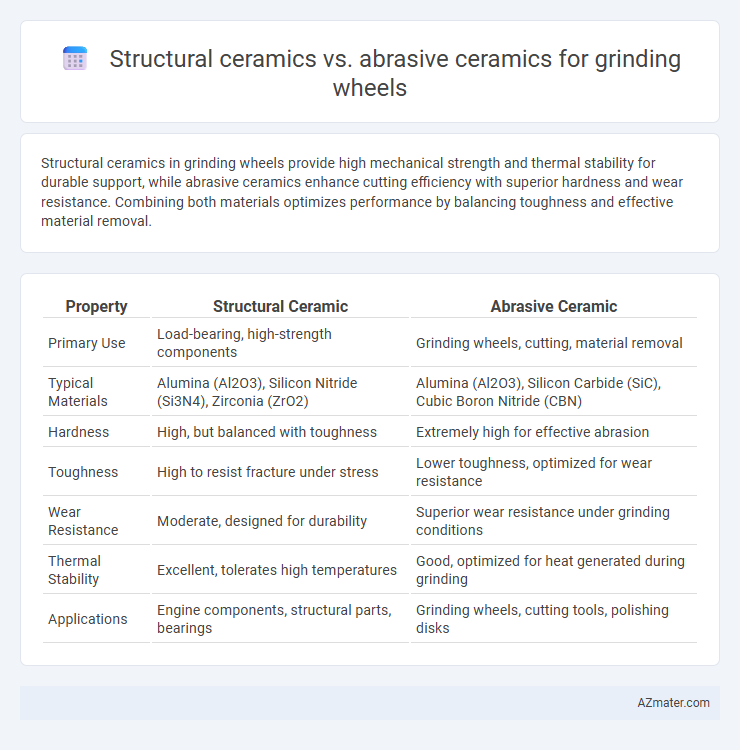Structural ceramics in grinding wheels provide high mechanical strength and thermal stability for durable support, while abrasive ceramics enhance cutting efficiency with superior hardness and wear resistance. Combining both materials optimizes performance by balancing toughness and effective material removal.
Table of Comparison
| Property | Structural Ceramic | Abrasive Ceramic |
|---|---|---|
| Primary Use | Load-bearing, high-strength components | Grinding wheels, cutting, material removal |
| Typical Materials | Alumina (Al2O3), Silicon Nitride (Si3N4), Zirconia (ZrO2) | Alumina (Al2O3), Silicon Carbide (SiC), Cubic Boron Nitride (CBN) |
| Hardness | High, but balanced with toughness | Extremely high for effective abrasion |
| Toughness | High to resist fracture under stress | Lower toughness, optimized for wear resistance |
| Wear Resistance | Moderate, designed for durability | Superior wear resistance under grinding conditions |
| Thermal Stability | Excellent, tolerates high temperatures | Good, optimized for heat generated during grinding |
| Applications | Engine components, structural parts, bearings | Grinding wheels, cutting tools, polishing disks |
Introduction to Ceramic Materials in Grinding Wheels
Structural ceramics in grinding wheels provide high strength, thermal stability, and wear resistance, making them ideal for maintaining wheel shape during precision grinding. Abrasive ceramics, composed primarily of aluminum oxide or silicon carbide, offer superior hardness and cutting efficiency, enhancing material removal rates and surface finish quality. Both ceramic types contribute to optimized grinding performance, with structural ceramics ensuring wheel durability and abrasive ceramics delivering effective cut and abrasion.
Overview of Structural Ceramics: Properties and Applications
Structural ceramics for grinding wheels exhibit high hardness, excellent wear resistance, and superior thermal stability, making them ideal for maintaining wheel shape and durability during high-stress applications. Common materials include alumina, silicon carbide, and zirconia, valued for their fracture toughness and resistance to mechanical shock. These ceramics are widely used in precision grinding of metals, aerospace components, and advanced engineering parts where consistent performance and longevity are critical.
Key Characteristics of Abrasive Ceramics
Abrasive ceramics used in grinding wheels feature high hardness, excellent wear resistance, and superior toughness, enabling efficient material removal and prolonged tool life. These ceramics, such as alumina and silicon carbide, provide sharp cutting edges that maintain performance under high-speed and high-temperature conditions. Their microstructure allows controlled friability, ensuring self-sharpening properties critical for precise grinding applications.
Material Composition: Structural vs Abrasive Ceramics
Structural ceramics used in grinding wheels typically consist of alumina, zirconia, or silicon carbide, selected for their high strength, toughness, and thermal stability, enabling them to support heavy mechanical loads. Abrasive ceramics, by contrast, are composed mainly of materials like aluminum oxide or silicon carbide grains that serve as cutting agents, designed for hardness and sharpness to effectively wear down workpieces. The key difference in material composition lies in structural ceramics providing durability and load-bearing capacity, while abrasive ceramics focus on cutting efficiency and wear resistance.
Performance Comparison: Durability and Strength
Structural ceramics in grinding wheels exhibit superior durability and mechanical strength due to their dense microstructure and enhanced fracture toughness, enabling prolonged service life under heavy-duty grinding conditions. Abrasive ceramics, while offering excellent hardness for aggressive material removal, typically possess lower toughness and are more prone to micro-cracking during high-stress operations. The balanced combination of durability and strength in structural ceramics results in fewer wheel replacements and lower downtime compared to the brittler abrasive ceramic counterparts.
Grinding Efficiency: Impact of Ceramic Type
Structural ceramics in grinding wheels offer superior toughness and thermal resistance, enhancing grinding efficiency by maintaining wheel integrity under high stress and heat conditions. Abrasive ceramics, designed for hardness and sharpness, provide aggressive cutting action that improves material removal rates but may wear faster under heavy loads. The balance between durability and cutting ability in the chosen ceramic type directly impacts grinding cycle time, surface finish quality, and overall process productivity.
Heat Resistance and Thermal Stability
Structural ceramics in grinding wheels are engineered for exceptional heat resistance, maintaining mechanical integrity at elevated temperatures up to 1000degC, which enhances durability during heavy-duty grinding. Abrasive ceramics offer superior thermal stability by dissipating heat efficiently to prevent thermal damage and minimize wheel glazing, sustaining cutting performance over extended use. The choice between structural and abrasive ceramics directly impacts heat management, with structural ceramics prioritizing toughness and abrasive ceramics optimizing thermal conductivity for consistent grinding efficiency.
Cost Analysis: Structural vs Abrasive Ceramic Grinding Wheels
Structural ceramic grinding wheels generally offer lower initial costs due to simpler manufacturing processes and materials, making them more cost-effective for general grinding applications. Abrasive ceramic grinding wheels, while typically more expensive upfront, provide superior hardness and wear resistance, leading to longer tool life and reduced replacement frequency, which can decrease overall operational costs in high-precision or heavy-duty environments. When analyzing long-term costs, abrasive ceramic wheels often deliver better value through enhanced efficiency and durability despite higher initial expenditures.
Industry Applications and Suitability
Structural ceramics, characterized by high strength and fracture toughness, are ideal for grinding wheels used in heavy-duty industrial applications such as automotive and aerospace component manufacturing, where durability and resistance to wear under high stress are critical. Abrasive ceramics, including aluminum oxide and silicon carbide, excel in applications requiring precision grinding and surface finishing, commonly employed in electronics, glass, and tool sharpening industries due to their superior hardness and cutting efficiency. Suitability depends on the grinding operation; structural ceramics perform well in coarse grinding and long-life tools, while abrasive ceramics are preferred for fine grinding and achieving tight tolerances.
Choosing the Right Ceramic for Your Grinding Wheel Needs
Choosing the right ceramic for your grinding wheel depends on the application's demands: structural ceramics offer superior toughness and thermal stability, ideal for high-stress grinding tasks requiring durability and precision. Abrasive ceramics, such as alumina or silicon carbide, provide exceptional hardness and cutting ability, making them suitable for aggressive material removal and finishing hard metals. Evaluating factors like workpiece material, grinding speed, and desired surface finish ensures optimal wheel performance and longevity in various industrial applications.

Infographic: Structural ceramic vs Abrasive ceramic for Grinding wheel
 azmater.com
azmater.com